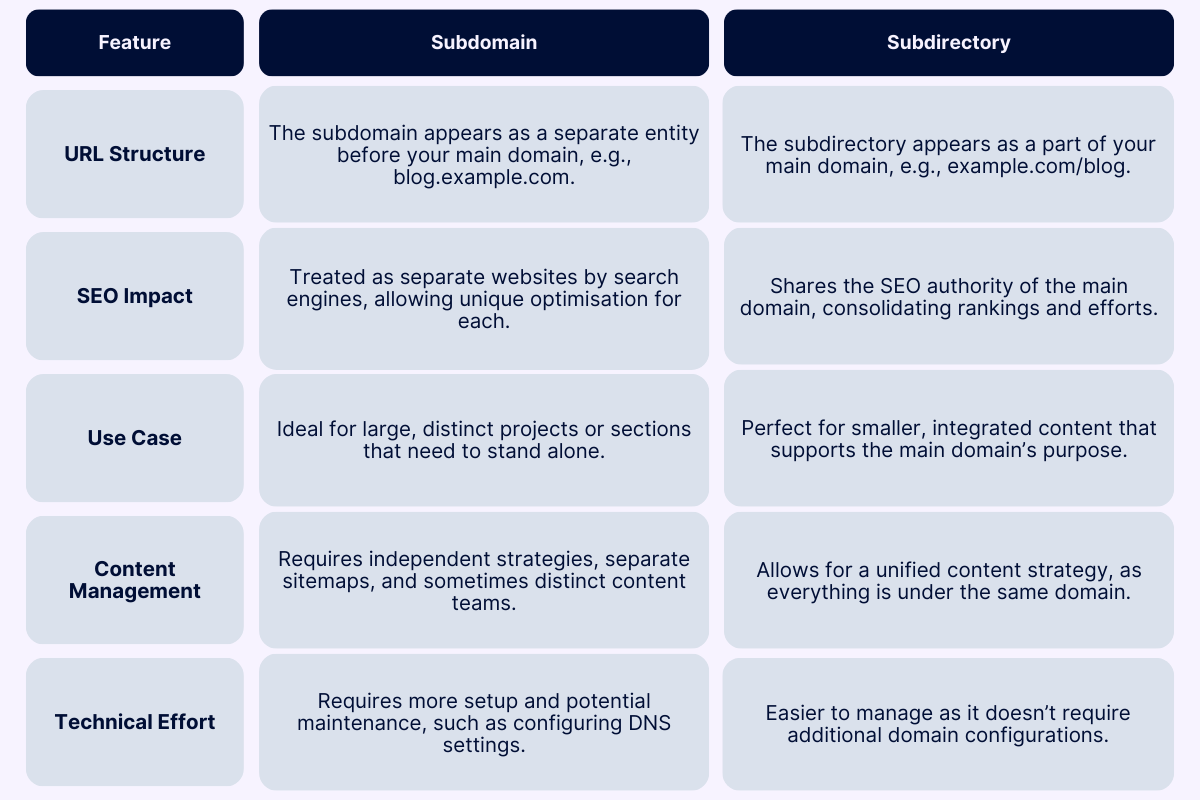If you’re a South African entrepreneur looking to supercharge your online presence, understanding the difference between subdomains and subdirectories can make a world of difference. Both are powerful tools that can help you organise your website, optimise for SEO, and create a better user experience.
With 1-grid’s high-value hosting and seamless domain registration services, structuring your website has never been easier. Let’s delve into the exciting world of subdomains and subdirectories and explore how they can elevate your website.
What is a Subdomain?
Picture your website as a bustling shopping mall. The main domain is the mall itself, while subdomains are the individual stores, each with its unique vibe and purpose. A subdomain is an extension of your primary domain, used to separate content into specific sections like blogs, online stores, or customer support hubs. For example:
- 1grid.co.za/blog/: Perfect for thought leadership and industry insights.
- shop.example.com: Tailored for e-commerce success.
- support.example.com: A dedicated space for FAQs and customer support.
Google treats subdomains as separate entities, which gives you the flexibility to build independent SEO strategies for each section. With 1-grid, creating subdomains is as simple as signing up for our high-value hosting plans. Our support specialists are always happy to guide you.
What is a Subdirectory?
Now, imagine your website is a house, and a subdirectory is just another room inside. Instead of creating a separate “mini-site,” subdirectories live directly under your main domain. For example:
- www.example.com/shop: Your e-commerce store.
- www.1grid.co.za/contact-us/: A hub for customer assistance.
Subdirectories keep everything under one roof, sharing the SEO authority of your main domain. Every update or improvement benefits the entire site, making it a seamless option for consolidating your content.
Subdomains vs Subdirectories: Key Differences

When Do I Use Subdomains?
Subdomains are ideal for:
- E-commerce Stores: Separate your online store from your main website for a more specialized shopping experience.
- Blogs: Highlight your expertise with a dedicated blog section.
- Support Portals: Streamline customer service with a focused help desk.
- Marketing Campaigns: Create landing pages for promotions without cluttering your main site.
Industry Insider Tip: Subdomains are treated as separate websites by search engines, so remember to optimise them individually with unique content, metadata, and sitemaps.
When Do I Use Subdirectories?
Subdirectories work best for:
- Small to Medium Websites: Consolidate all your content under one domain for easier management.
- Blogs and Portfolios: Strengthen your main site’s SEO by keeping everything in one place.
- Localised Content: If your focus is on building one cohesive brand, subdirectories make navigation simpler for users.
Industry Insider Tip: Keep your URL structure clean and logical, and regularly update your content to maintain SEO authority.
How to Set Up Subdomains with 1-grid
Setting up a subdomain might sound like rocket science, but it’s as easy as 1-2-3 with 1-grid. Here’s how:
- Log in to your 1-grid hosting account.
- Navigate to the Control Panel.
- DNS Zone Management and click on “Add Subdomain.”
- Enter your subdomain name (e.g., “blog” for blog.yourdomain.co.za).
- Save your changes and let the DNS magic happen!
Need assistance? Our team of Support Specialists are just a call (+27 21 200 1200) or click away!
Why Choose 1-grid for Your Hosting Needs?
At 1-grid, we understand the unique challenges South African entrepreneurs face. That’s why we offer low-cost and high-value hosting packages, user-friendly tools and specialised technical support.
Whether you choose subdomains or subdirectories, the right structure can make all the difference in your online journey. With 1-grid by your side, you’ll have the tools, tips, and top-notch hosting solutions to make your digital dreams a reality. Let’s build something amazing together!
